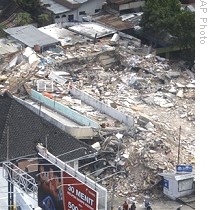Jakarta
21 October 2009
Indonesia is one of the most earthquake-prone nations in the world. After the devastating earthquake in Padang last month that killed thousands, disaster-management experts are recommending ways to reduce the casualties and damage caused by natural disasters.
 |
| Aerial image of buildings destroyed by earthquake in Padang, West Sumatra, Indonesia, 03 Oct 2009 |
Geophysicist Jessica Sigala, with the U.S. National Earthquake Information Center, says the number of quakes that occur each year has been relatively constant.
"Right now I am looking at a table that shows the frequency of earthquakes by magnitude in the world and on average we see about 17 earthquakes in the magnitude seven to 7.9 range and that is on average," she said. "We've had 14 in this magnitude seven range this year. So we are pretty average right now."
Indonesia and many other countries in the Asia-Pacific region sit along fault lines separating sections of the Earth's crust known as tectonic plates. The shifting of these plates can cause earthquakes, volcanic eruptions and tsunamis. The number of volcanoes and earthquake fault lines, stretching from Alaska in North America, down to South America and across the Pacific to Indonesia and up to Japan, is nicknamed the "Ring of Fire".
John Holmes, the United Nations emergency relief coordinator, says earthquakes contribute to make the Asia-Pacific region the most disaster-prone in the world.
"I think something like 70 percent of the world's disasters, natural disasters happen in this part of the world," he explained. "And I saw a figure the other day that actually 99 percent of the natural disaster deaths last year were in the Asia-Pacific region."
Holmes and disaster management experts say communities in high-risk areas can act to reduce the loss of life and damage in the future.
Brian Tucker is president of Geo Hazards International, which specializes in preventing loss of life from natural disasters. He says the technology to make buildings more earthquake resistant is not that complicated.
"It is not rocket science, as we say. Basically you just have to make sure the walls are connected to one another so that they don't separate from each other in strong shaking," he noted. "They should be tied together. They should be tied to roof members, or if it is a multi-story structure, the walls need to be tied to the floors of each floor."
Tucker is helping rebuilding efforts in Sumatra. He says the coastal city Padang, which suffered massive damage in the quake, also is at high risk for tsunamis.
"There's a tremendously high probability of a tsunami occurring in Padang, offshore Padang," he added. "And the rough estimate is that something like 100,000 people would be inundated by a tsunami wave of anywhere between five and 10 meters high. And there is a good chance of such a tsunami occurring in the next, in the lifetime of the kids that are alive today in Padang."
In addition to earthquake-resistant construction, he says the city should take additional measures: move schools, hospitals and other essential buildings outside the high-risk area, make sure there are adequate roads to quickly evacuate the city, and build a number of tall structures in the city that can provide shelter from the waves.
In nearby rural areas, the quake triggered landslides that buried entire villages. Adelina Kamal, the head of disaster management for the Association of Southeast Asian Nations, says moving other at-risk villages would almost certainly encounter local resistance.
"Probably they don't want to leave their house and their land because their land is so fertile and this is part of their asset. So it is very much on the awareness of the people," she said. "They have to know first the risk associated with their lives, their homes, whether they live in a safe area, whether their house is safe."
But Geo Hazards' Tucker says even in those situations technology can reduce risks. In Japan, walls have been built to protect villages from landslides.
All these measures cost money, but the United Nations' Holmes recommends using a portion of recovery funding on prevention.
"So a 10 percent figure of what you are spending on response or even perhaps on development should go into disaster-risk reduction because that is a good investment," he noted.
He says every dollar spent on disaster risk reduction will save $7 on future emergency response costs.